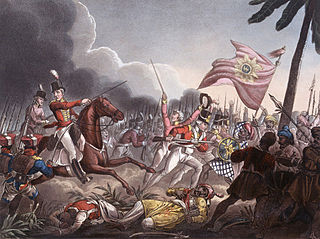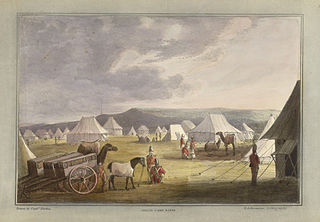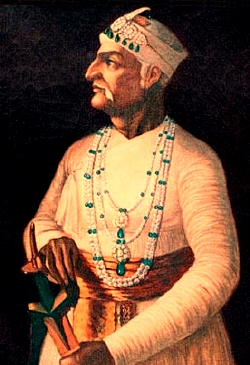
Bajirao I, born as Visaji, was the 7th Peshwa of the Maratha Empire. He after Shivaji, is considered to be the most charismatic and dynamic leader in Maratha history. He was just twenty years old and already had a reputation for rapid decisions and a passion for military adventure.

Hyderabad State was an independent monarchy/princely state located in the south-central Deccan region of Indian Subcontinent with its capital at the city of Hyderabad. It is now divided into the present-day state of Telangana, the Kalyana-Karnataka region of Karnataka, and the Marathwada region of Maharashtra in India.

The Maratha Confederacy was an early modern polity in the Indian subcontinent comprising the realms of four independent Maratha Rajas and the Peshwa. It began in 1674 with the coronation of Shivaji of the House of Bhonsle as the Chhatrapati of the Marathas in 1674. The Maratha realm was recognised by Bahadur Shah I, the Shahenshah of Hindustan as a tributary state in 1707 after a prolonged rebellion. The Marathas continued to recognise the Emperor as their nominal suzerain similar to other contemporary Indian entities.

Mir Qamar-ud-din Khan Siddiqi also known as Chin Qilich Qamaruddin Khan, Nizam-ul-Mulk, Asaf Jah and Nizam I, was the first Nizam of Hyderabad. He was married to the daughter of a Syed nobleman of Gulbarga. He began his career as a favourite of the Mughal emperor Aurangzeb, who made him a general. Following the death of Aurangzeb in 1707, Asaf Jah refused to favour any one of Aurangzeb's warring sons and as such remained neutral. When Aurangzeb's third son Bahadur Shah ultimately emerged victorious, Asaf Jah was rotated as governor of multiple Mughal provinces until 1714, when he was created Viceroy of the Deccan with authority over six Mughal provinces in southern India from 1714 to 1719. From 1719 onwards he was involved in combating the intrigues of the Sayyid Brothers. From 1720 to 1722 he helped the new Mughal emperor Muhammad Shah eliminate the Sayyed brothers and was rewarded by being elevated to the grand viziership from 1722 to 1724.

The Battle of Assaye was a major battle of the Second Anglo-Maratha War fought between the Maratha Empire and the British East India Company. It occurred on 23 September 1803 near Assaye in western India. An outnumbered Indian and British force, under the command of Major General Arthur Wellesley, defeated the combined Maratha army of Daulatrao Scindia and the Bhonsle Raja of Berar. The battle was Wellesley's first major victory and the one he later described as his finest accomplishment on the battlefield, even more so than his more famous victories in the Peninsular War, and his defeat of Napoleon Bonaparte at the Battle of Waterloo.

The Third Anglo-Maratha War (1817–1819) was the final and decisive conflict between the British East India Company and the Maratha Empire in India. The war left the Company in control of most of India. It began with an invasion of Maratha territory by British East India Company troops, and although the British were outnumbered, the Maratha army was decimated. The troops were led by Governor General Hastings, supported by a force under General Thomas Hislop. Operations began against the Pindaris, a band of Muslim mercenaries and Marathas from central India.

Nizam of Hyderabad was the title of the ruler of Hyderabad State. Nizam is a shortened form of Niẓām ul-Mulk, which means Administrator of the Realm, and was the title bestowed upon Asaf Jah I when he was appointed Viceroy of the Deccan by the Mughal Emperor Farrukhsiyar. In addition to being the Mughal Viceroy (Naib) of the Deccan, Asaf Jah I was also the premier courtier of the Mughal Empire until 1724, when he established the independent monarchy of Hyderabad and adopted the title "Nizam of Hyderabad".

The Anglo-Mysore Wars were a series of four wars fought during the last three decades of the 18th century between the Sultanate of Mysore on the one hand, and the British East India Company, Maratha Empire, Kingdom of Travancore, and the Kingdom of Hyderabad on the other. Hyder Ali and his succeeding son Tipu fought the wars on four fronts: with the British attacking from the west, south and east and the Nizam's forces attacking from the north. The fourth war resulted in the overthrow of the house of Hyder Ali and Tipu, and the dismantlement of Mysore to the benefit of the East India Company, which took control of much of the Indian subcontinent.

Pierre Cuillier-Perron was a French military adventurer in active in India.
Kharda(Shivpattan)is a township in the Indian state of Maharashtra. It lies near Ahmednagar District’s south-eastern border with Osmanabad District and Beed District, and is 18 km south-east of Patoda. Rajuri is 17 km north-west, while Int is 13 km towards the south-east. Ahmednagar is around 100 km north-west. Kharda is well connected to the taluka headquarters of Jamkhed via road. Kharde-patils who now belong to Kolhar of Rahata Taluk, Ahmednagar District find their roots to this place. Surve, who are one of the 96k, migrated to Kharda, later on came to be known as Kharde.

Mirza Nizam Ali Khan Siddiqi, Asaf Jah II was the 5th Nizam of Hyderabad State in South India between 1762 and 1803. He was born on 7 March 1734 as fourth son to Asaf Jah I and Umda Begum. His official name is Asaf Jah II, Nizam ul-Mulk, Nizam ud-Daula, Nawab Mir Nizam 'Ali Khan Siddiqi, Fateh Jang, Sipah Salar, Nawab Subedar of the Deccan. Sawānih-i-Deccan, a Persian work compiled by Munim Khan, a military commander during the era of Asaf Jah II gave more insight about administration of Asaf Jahis.
Colonel John William Hessing was a Dutch military officer who served in the armies of the Maratha Empire in the late 18th and early 19th centuries.

Chanda Sahib was a subject of the Carnatic Sultanate between 1749 and 1752. Initially he was supported by the French during the Carnatic Wars. After his defeat at Arcot in 1751, he was captured by the Marathas of Thanjavur and executed.

Madhavrao II was the 12th Peshwa of the Maratha Empire in India, from his infancy. He was known as Sawai Madhav Rao or Madhav Rao Narayan. He was the posthumous son of Narayanrao Peshwa, murdered in 1773 on the orders of Raghunathrao. Madhavrao II was considered the legal heir, and was installed as Peshwa by the Treaty of Salbai in 1782 after First Anglo-Maratha War.

Mu'inud-Daulah, Mushirul-Mulk, Azamul-Umara, Arastu Jah, a man of Persian descent, was the Diwan or the Prime Minister of Hyderabad during the reign of Nizam Ali Khan from 1778 until his death in 1804.
The Battle of Rakshasbhuvan in India was fought on 10 August 1763. After the defeat of the Maratha Confederacy at the Battle of Panipat, their rivals started seizing the opportunity to recover their losses in the past at the hands of Marathas. Particularly, the Nizam of Hyderabad wanted to recover territory he had lost at the Battle of Udgir. He decided to launch a war on the Marathas.

The Siege of Trichinopoly was part of an extended series of conflicts between the Nizam of Hyderabad and the Maratha Empire for control of the Carnatic region. On 29 August 1743, after a six-month siege, Murari Rao surrendered, giving Nizam ul Mulk (Nizam) the suzerainty of Trichinopoly. By the end of 1743, the Nizam had regained full control of Deccan. This stopped the Maratha interference in the region and ended their hegemony over the Carnatic. The Nizam resolved the internal conflicts among the regional hereditary nobles (Nawabs) for the seat of governor (Subedar) of Arcot State, and monitored the activities of the British East India company and French East India Company by limiting their access to ports and trading.
The Battle of Bhopal was fought on 24 December 1737 in Bhopal between the Maratha Empire and the combined army of the Nizam and several Oudh generals in which Marathas under Bajirao I were victorious.
Events in the year 1795 in India.

The Maratha invasion of the Deccan in 1739, led by Peshwa Bajirao I, was a military campaign of the Maratha Empire against the Nizam of Hyderabad. Bajirao's Maratha forces invaded Hyderabad's territories and had a military conflict with Nasir Jung, the son of Nizam-ul Mulk, Asaf Jah.














